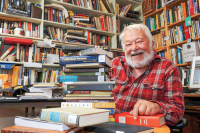Development done right: Failed projects open door for those taking the long view
 Randy Best was a rare bird in the development heyday of the 2000s. Where others just saw dollar signs, Best actually saw land.
Randy Best was a rare bird in the development heyday of the 2000s. Where others just saw dollar signs, Best actually saw land.
“I would spend a month walking a piece of property after we bought it. I walked every inch and when I was done, I knew where every house site was going to be, where every septic was going to be, how the roads would lay,” said Best, a Haywood County native.
Best read the land like a book. He could tell where seasonal seeps were likely to be by the feel of the earth under his boots. He could tell where large boulders were hidden below ground by the type and size of trees that grow in thin soils.
Armed with nothing but flagging tape and an inclinometer, he would start marking off the roads and lots, eyeing the layout like an artist’s canvas, fiddling until it was just right. It was all self-taught — something he stumbled into by happenstance and discovered he had a real talent for. But Best had something else, something out-of-town developers could never duplicate.
“I am from here,” Best said. “I love land, too. That’s a passion of mine. I love land. I hate to see a development butchered.”
Best planned and built four developments in Haywood County during the 2000s, all of them known for quality roads and thought-out lot designs.
Related Items
But Best wasn’t immune from the real estate bust. He and his two partners, also local Haywood County men, pulled off four successful developments over an eight-year period. They paid cash when they could, funding the upfront cost of raw land and roadwork for their next development with the profits from the previous one.
But they had just launched their fifth project when the market crashed, and they were stuck with land — this time bought on bank loan — but no lot sales coming in to make the payments.
“Whenever the recession hit we thought maybe it would be a year or two, so we held out, but it rocked on and didn’t get better and we thought one more year,” Best said. “Here it is six years later. No one really saw it coming, except maybe my wife.”
Best’s heritage follows the classic story of mountain men in Haywood County. His grandparents were farmers, but his dad, like so many of that post-WWII generation, went to work for Champion Paper Mill.
Best also chose the path of industry and became a welder, briefly traveling the country as a young man to work on big industrial jobs. At 24, he came back home and got a job at Champion Paper Mill like his father. But his life changed the day he got a bulldozer.
“I bought a little bulldozer for my mountain place to clear the hawthorns off,” Best said.
As often happens to a guy with a bulldozer, people began asking him to do small jobs on their land, maybe smooth out their driveway or grade a spot for a shed.
Best liked running equipment, and he was good at it. He started picking up jobs on weekends and evenings. Those small jobs became bigger jobs, and his small bulldozer turned into a bigger one.
Soon the jobs were more than he could do on the weekends, so he hired men to run his growing fleet of machinery, and that’s how he ended up with a successful grading company, Randy Best Excavating.
He eventually quit his job at the paper mill in the late ‘90s and went into the development business with two other local men as partners.
By the time the boom was in full swing, the playing field was a crowded one, with speculative investors descending on the mountains to make their fortunes.
But unlike these big city developers who swooped in from the outside when the market was hot, Best wasn’t going anywhere. He was born here, and planned to die here. Every development he did had his name on it, and he cared about his reputation.
“I wanted to build good roads,” Best said. “If I do bad work, then I won’t get any other calls.”
Unfortunately, not everyone shared Best’s code of ethics. The honor system was no match for the stark lack of regulations during the early 2000s. Some developers didn’t know any better and hired unqualified graders. Others cut corners intentionally.
“It was just going too wild back then and everybody with a little bit of money came in and started buying tracts of land and they were all going to be developers,” Best said. “A lot of them didn’t know what they were doing or who to get to do the work. Most of the good grading contractors were tied up, and they started hiring anybody they could.”
By the bootstraps
Unlike most developers who pulled up their stakes and moved on, Best has stayed with it, reviving the abandoned subdivision of Avalon, which straddles a mountainside above Lake Junaluska.
Turnaround stories are hard to come by in the wake of the real estate bust. Dozens of unfinished developments are trapped in purgatory with no clear way out, languishing under the column of “distressed assets.”
It’s rare for a new buyer to come along and pick up the reins of the development as Best and his new partners have with Avalon.
Best has seen a lot of foreclosed developments come on the market, but none with the potential of Avalon. The roads were well-built initially — a must in Best’s book. But they were abandoned when the developer went under.
“He ran out of money and hit the wall. Then the roads got worse and worse and worse,” said Donny Ray, a homeowner in Avalon.
Avalon was one of half a dozen developments in the repertoire of Robert Ullmann, an Atlanta developer who amassed more than 4,000 acres in Haywood, Jackson, Macon and Swain counties during the mid-2000s. He launched the developments concurrently, but when the bust came, he lost most of them in foreclosure or to short sales.
On Avalon, Ullmann owed SunTrust more than $4 million at the time it foreclosed in 2010.
SunTrust wanted to sell it for whatever it could get. But the roads needed maintenance, and that’s when Best first entered the picture.
“The bank hired me to go in and get the development shaped up, and so we got all the grading done and back into shape, and they said they wanted to sell it,” Best said.
That year, 2010, was one of the worst for real estate. Economic forecasters had finally stopped predicting a turn-around and wizened up that the Great Recession would be with us for the long haul.
For mountain real estate, the hit was doubly bad. Prices didn’t merely fall, but crashed from ridiculous heights given the vastly over-inflated, speculative prices of the boom days.
And it was in this climate that Best and two partners plunked down $900,000 cash for Avalon. It was a steal, but that was the nature of 2010.
“They were wanting to dump it and get rid of it,” Best said.
Avalon was a gem — a platted 400-acre subdivision on the edge of Waynesville with wide roads, good views, underground utilities and even city waterlines already installed.
Best — along with Hal Roberts, who owns a large tract of land right adjoining Avalon, and Lee Farnsworth — formed a three-man partnership dubbed RFB, borrowing the initials of their last names, and relaunched the development.
Fall from grace
Avalon was a winner when it was started in 2006. The lots in its first phase sold effortlessly — about 30 in all, going for an average of $190,000 a pop.
But by 2010, the market was at rock bottom and Avalon was at a standstill. With the development in foreclosure, lot owners were in limbo and afraid to build homes. The roads were deteriorating, and any hope of a quick rebound in the real estate market had been dashed.
Some lot owners in Avalon quit paying on their own bank loans and let their lots fall into foreclosure. Others sold their lots for pennies on the dollar compared to the price they’d paid just four years earlier.
A quick gander through the property records of lots in Avalon shows some stark examples of the plummeting lot prices. A lot that sold in 2006 for $190,000 was sold in foreclosure for just $8,500 in 2010. Another lot that sold for $190,000 in 2006 was unloaded by its owner for $10,000 in 2010.
But when Best and his partners came on the scene in late 2010, the tide turned.
“Before we took it over, it looked like a ghost town in there,” Best said. “People were waiting to see what was going to happen. They are very glad we took it over.”
Since then, four of those initial 30 lot owners have built homes in Avalon. Among them are Donny and Mindy Ray, who are now living their retirement dream from an $800,000 mountain-top home at 3,800 feet.
But their view wasn’t always so rosy.
Dashed dreams
Retirement was a highly planned affair for the Rays, who both worked for three decades at the Central Intelligence Agency in Virginia. They had no kids, plenty of savings and planned to retire on the early side.
They began looking for property in 2004, when they got wind of Avalon.
“His dad cut out an ad in the Atlanta newspaper and put it in an envelope and sent it to us. We said, ‘Huh, that sounds interesting,’” Mindy recalled.
They found their dream lot and bought it on the spot. Planning their retirement home became an all-consuming hobby. Donny spent every weekend poring over house designs. They made regular trips to Haywood County, often spending the afternoon sitting on their lot in lawn chairs with a bucket of Kentucky Fried Chicken, imagining what their home would be like.
But then the recession came, and they hit an unexpected snag. They went to bank after bank — seven in all — seeking construction loans to no avail.
“We were in no man’s land for a while trying to get a loan,” Donny said. “They just didn’t want to loan money. They would come up with something that would shoot you down.”
They often seemed close, but banks would get cold feet. Once, at the end of a long loan application process and after forking over money for yet another appraisal, they were approved. But the vice president of the bank said he wanted to visit the lot personally before signing off.
By then, the development was in foreclosure and the road system was in disrepair, rutted and muddy, passable only by four-wheel drive in parts.
“He said, ‘I don’t like what I see, so no loan,’” Donny recounted.
The Rays were forced to sideline their retirement plans.
“We pulled in our papers and kept on working,” Donny said.
“It depresses you,” Mindy added. “We were in total limbo. We paid all this money for the land and didn’t know what was going on with the development.”
When Best and his partners bought Avalon out of foreclosure, their worrying wasn’t over yet.
“It could have ended up being a fly-by-night outfit,” Donny said.
But it wasn’t. Roads were fixed, and the new owners quickly established an onsite presence.
“I can call, I can send a text, I can send a note and they respond immediately,” Donny said. “They are in it for the long haul.”
Although confidence has been restored in Avalon — the Rays finally got their loan and built their house — there are just four homes in the development to date. The Rays would like to have more neighbors.
“Hopefully, people will start buying and building,” Donny said.
They have become de facto ambassadors for the development. During winter, they sent photos of Avalon in the snow to out-of-state lot owners. And they’ve extended an open invitation to neighbors to stay with them when coming up to check on their lot or meet with builders.
On the way up
The new owners of Avalon have just launched a major marketing campaign this summer. They haven’t sold a lot yet but have several serious buyers in the wings, according to Andy Baker, the owner of TFM Carolina, a real estate and development firm that’s handling Avalon’s marketing and sales.
TFM — which stands for Terra Ferma Management — is billed as a one-stop shop for developments trying to make a come back. Whether a bank has a development and doesn’t know what to do with it, or a new developer has come into an abandoned subdivision mid-stride, Baker helps them chart a new course.
Baker’s seen an interesting shift over the past few years in the type of lots buyers want. The idyllic notion of a mountain getaway on a far-flung ridgetop or hidden valley now comes with a caveat: can I still get to town in 10 minutes?
“Location is one of the top things,” Best said. “Used to be that didn’t matter as much, but people are changing their minds on that.”
Avalon’s proximity to town — on the edge of Waynesville and less than 10 minutes to the grocery store — gives it huge leverage, according to Baker. When he’s taken prospective buyers to see more remote developments, they get weary of driving up and down gravel roads to get to a lot.
“We looked at developments where it was like, ‘Wow, are we there yet?’” Mindy Ray recalled. “If I can’t be at the Super Walmart in 15 or 20 minutes, forget it.”
Its proximity to town allows Avalon to tap a different sort of home-buyer: working professionals with families.
Baker said he’s seen the average age of buyers in mountain subdivisions trend younger, with more couples in their 40s and 50s with school-aged kids buying into the former second-home and vacation market.
“I think is interesting from a demographic standpoint,” he said.
The crash in second-home demand led to lower prices, which means real estate in what were once high-end developments has come within reach for professional couples with families.
Today’s developers are retooling the kind of communities they offer. The fancier, high-dollar amenities once considered ubiquitous aren’t as important to the younger buyers.
“They say, ‘Is there a club house?’ and we say, ‘No’ and they say, ‘Good,”” Baker said. “The idea of golf courses and club houses is changing to things like community farms and trail systems for biking and hiking.”
Secret weapon
Avalon’s lots aren’t as cheap as some on the market, particularly in bank-owned developments where lots are unloaded at fire sale prices. But Avalon offers buyers security in the uncertain landscape of abandoned developments.
“They want to know more than ever who is behind the project, financially is it secure, and they want to see the infrastructure in,” Baker said. “To take that one step further, who are the developers? They want to put a face to a name.”
While Best cut his teeth in the development business behind the levers of a bulldozer, his real forte is his human nature, which makes him one heck of a salesmen for Avalon, even if he doesn’t mean to be.
“To introduce Randy to any of these folks you get a sense of trust and that speaks volumes … and knowing that the person, believe it or not, actually cares about the community,” Baker said.
Best’s pride in Avalon is clear. Touring the development recently, he was like a kid showing off his new Christmas presents. He paused at a favorite homesite to show the great views and rattle off the names of distant mountains, checked on the fish stocked in the community pond and couldn’t help point out the good, paved roads winding up the mountain.
“I plan on being right here. This is my retirement,” Best said.
Last modified on Wednesday, 18/06/2014









